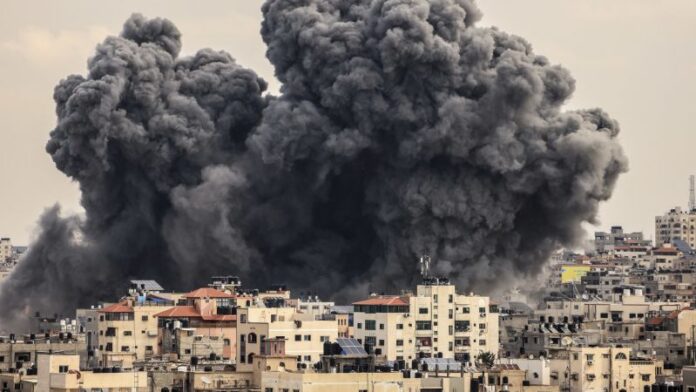GAZA: Israeli forces continue to bombard the Gaza Strip with airstrikes while also engaging in ground skirmishes with Hamas, with over 436 people killed in Israeli aerial attacks.
Most of the casualties occurred in the densely populated southern region of Gaza, with the conflict expanding beyond Gaza, with Israeli aircraft conducting strikes in southern Lebanon.
Additionally, Israeli troops clashed with Palestinians in the occupied West Bank.
The United Nations has expressed deep concern about the humanitarian situation, as civilians in Gaza are running out of food, water, and shelter. Although some aid reaches Gaza, it falls far short of the amount needed to address the crisis.
The death toll on the Palestinian side continues to rise, with over 5,087 Palestinians killed in two weeks of Israeli airstrikes, including 2,055 children, according to Gaza’s health ministry.
The current Israeli bombardment was triggered by a cross-border assault by Hamas militants on Israeli communities on October 7, resulting in casualties and hostage-taking.
Both Israel and Hamas have reported clashes in Gaza.
Israel has indicated that its ground forces conducted limited raids to combat Palestinian gunmen, while airstrikes focused on sites where Hamas was believed to be preparing for potential attacks.
Israeli military spokesperson Rear Admiral Daniel Hagari explained that these raids targeted groups of terrorists and collected information about hostages held by Hamas.
It is also not clear how such an invasion might unfold.
Hamas has built up a powerful arsenal with Iran’s help, and Israeli forces would risk being drawn into fighting in a crowded urban setting against a group that has built a vast tunnel network referred to by Israeli troops as the “Gaza Metro”.
“During the night there were raids by (Israeli) tank and infantry forces,” Hagari told a briefing.
Describing incursions that went “deep” into Gaza, he said: “These raids are raids that kill squads of terrorists who are preparing for the next stage in the war.”
Gaza’s Hamas-run interior ministry reported an Israeli airstrike in the Al-Saudi and Janina neighbourhoods of Rafah, near the southern border with Egypt.
Izz el-Deen al-Qassam Brigades, the armed wing of Hamas, said in a statement on Sunday that its fighters had engaged with an Israeli armoured force east of Khan Younis in southern Gaza.
“Fighters engaged with the infiltrating force, destroying two bulldozers and a tank and forced the force to withdraw, before they returned safely to base,” it said.
It said on Monday that it had also targeted two Israeli military posts in southern Israel with drones. The Israeli military said two drones had been identified crossing from Gaza into Israeli territory and were thwarted.
Israel has said its military campaign will exceed any previous moves against Hamas, but the Palestinian group has proved capable of surprising Israel in the past and will be fighting in a dense urban setting with powerful weapons.
Based on what happened in Israeli incursions in 2008 and 2014, Israel’s bunker-buster bombs and hi-tech Merkava tanks will be up against a vast network of deep tunnels, booby-traps and arms, including Russian-made Kornet anti-tank missiles.
The conflict shows no signs of abating and remains highly volatile. Israel has amassed troops and tanks along its border with Gaza, but the timing of a potential ground invasion is uncertain.
The conflict is being fought in densely populated urban areas with an extensive network of tunnels.
The international community, including the United States, has expressed concerns about the escalating violence.
The United Nations has called for an immediate ceasefire, and humanitarian organisations are struggling to provide aid to those affected by the conflict.
As the situation in the region remains fluid, there is a growing fear that the Israel-Hamas war could lead to a wider regional conflict, especially given Hezbollah’s involvement along Israel’s northern border with Lebanon.























